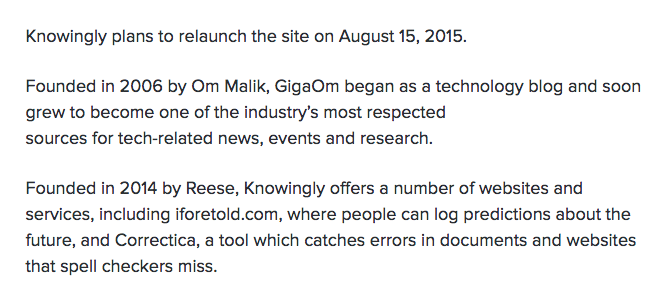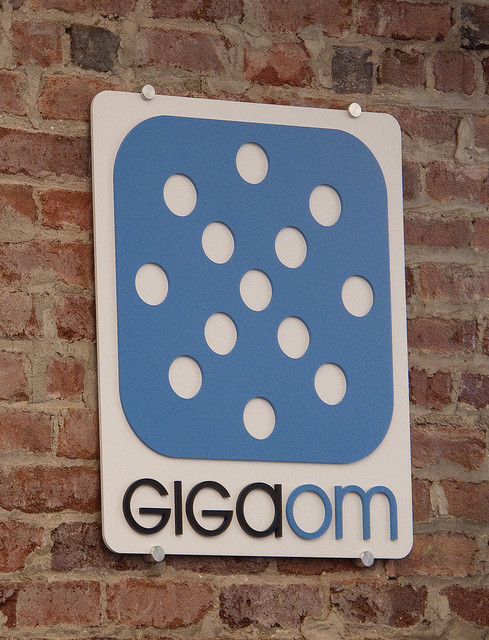
On a Monday night in March, Gigaom, the site where I’d worked for four years, abruptly shut down. In a hastily scheduled conference call, the company’s 80-plus employees were told that we’d run out of money and would cease publishing immediately. Our long-planned conference Structure Data, which was just nine days away, was canceled.

The next few weeks passed in a cloud of booze, commiseration, and anxiety. Today, six months later, most of my former colleagues are happily settled in new jobs.
Gigaom, meanwhile, has turned out to be…sort of not dead. Content is being published again on Gigaom.com, though it’s being written by none of the original Gigaom writers. And the conferences are coming back to life as a separate company, Structure, led by several former Gigaom employees. I decided that enough time had passed — I’ve now been here at Nieman Lab for about four months — to do an only semi-completely-conflicted exploration (disclosure!) of how Gigaom came back from the dead.
There are a lot of questions these days about the value of a news brand. But we can probably agree that having an established name in media is probably more helpful than not. At the same time, though, much of a brand’s value comes from the people behind it.
So what happens when the brand remains but the people don’t? What about when the same people are there and the brand name is not? Can a conference business thrive without the media brand that built it?
Some brief background: If you’re not familiar with Gigaom, it was a technology news and analysis site founded by Om Malik in San Francisco in 2006. The company ran very successful conferences and, in 2009, launched a research business that was originally intended to be a lower-priced alternative to products like Forrester. It acquired paidContent, where I worked, in 2012. The CEO left in 2014; Michael Rolnick, a new CEO, came on in January 2015, and two months later the company shut down. (The best article I read on the shutdown was this one by Farhad Manjoo.)“There’s no case I can think of where something the size of Gigaom effectively went under and then re-emerged under the same name, with a completely different management team and ownership structure, but still trying to do the same thing,” Mathew Ingram, a former senior writer at Gigaom who is now at Fortune along with many of my other former colleagues, told me. In the case of Gigaom, however, that’s exactly what happened.
After the shutdown, it was unclear what was going to happen to Gigaom’s archives. Our editorial team scrambled to save our posts with software like Evernote, not knowing if they would suddenly disappear. Then, in May, we found out that an Austin-based company called Knowingly had acquired Gigaom.com and its assets — the domain name and our entire archives, which were still pulling in a fair bit of ad revenue through Google AdSense — and was planning to relaunch the site, without any of the original writers on board.

Knowingly’s CEO is Byron Reese. Reese was the chief innovation officer at content farm Demand Media until 2013. He declined to talk with me for this story: “I really am trying to stay focused on rebuilding the site and services, so in the interest of that, I am just declining all press opportunities about Gigaom at this time,” he told me via email.
 In the meantime, there’s new content being published on Gigaom.com. I noticed a couple of frequent bylines: Tom Cheredar, formerly a media reporter at VentureBeat and media editor at The Daily Dot, and Nathaniel Mott, a former reporter at PandoDaily. Both said they couldn’t talk about Gigaom’s future plans. “I can tell you that Knowingly hired me last month as an editorial advisor to Gigaom, which includes having me ‘turn the lights back on’ by coordinating with a handful of freelancers to publish a few articles to the site during the weekdays,” Cheredar told me in an email. “The site definitely hasn’t relaunched, as that would require having a staff of full-time reporters/editors.”
In the meantime, there’s new content being published on Gigaom.com. I noticed a couple of frequent bylines: Tom Cheredar, formerly a media reporter at VentureBeat and media editor at The Daily Dot, and Nathaniel Mott, a former reporter at PandoDaily. Both said they couldn’t talk about Gigaom’s future plans. “I can tell you that Knowingly hired me last month as an editorial advisor to Gigaom, which includes having me ‘turn the lights back on’ by coordinating with a handful of freelancers to publish a few articles to the site during the weekdays,” Cheredar told me in an email. “The site definitely hasn’t relaunched, as that would require having a staff of full-time reporters/editors.”
So far, the posts being published to Gigaom are a mixture of embargoed product stories, takes on news, and long interviews by Reese. It’s tough to spot a unifying theme or worldview, which could make it hard for the site to compete as an actual destination on the Internet. I know that it’s early days (and, again, I’m 100 percent biased), but the new content on Gigaom lacks the spark and passion that, I think, kept people reading us in the past. Gigaom writers had spent years building their personal brands, and — I think, I hope — when they left, their followers went with them.
Maybe it doesn’t matter. Maybe a brand makes less of a difference now, since most people aren’t visiting individual sites anyway but are instead finding news through big platforms like Facebook. “If your stuff is decent you’ve got as much of a chance as anyone, theoretically,” Ingram said. “You don’t have the manpower, the following to really kill it, but at least you have the chance — whereas you might not have before when brands like that made a big difference. But it can also limit your upside. To someone going through their Facebook feed, you look the same as everything else.”
![]() There’s another bet on the brand of Gigaom’s former conference business. It’s being reborn as Structure, an independent conference business backed by Charles Beeler, a partner at San Francisco VC firm Rally Ventures. Some of my former colleagues are overseeing this relaunch: Clare Ryan, who was VP of events at Gigaom, is now president and CEO of Structure. Former members of Gigaom’s marketing team are working for her on contract; Tom Krazit, the former executive editor of Gigaom, is overseeing Structure’s content strategy. Magnify, the events team that we used at Gigaom, will put on the Structure events. And Gigaom’s former senior writers — Stacey Higginbotham, Derrick Harris, Barb Darrow, Janko Roettgers — will moderate panels.
There’s another bet on the brand of Gigaom’s former conference business. It’s being reborn as Structure, an independent conference business backed by Charles Beeler, a partner at San Francisco VC firm Rally Ventures. Some of my former colleagues are overseeing this relaunch: Clare Ryan, who was VP of events at Gigaom, is now president and CEO of Structure. Former members of Gigaom’s marketing team are working for her on contract; Tom Krazit, the former executive editor of Gigaom, is overseeing Structure’s content strategy. Magnify, the events team that we used at Gigaom, will put on the Structure events. And Gigaom’s former senior writers — Stacey Higginbotham, Derrick Harris, Barb Darrow, Janko Roettgers — will moderate panels.
“I am delighted that former team members are relaunching the Structure series of conferences and really glad to see it in the hands of great people like Tom and Clare,” Om Malik, who is not involved with the conferences, told me.
“[Gigaom] conferences were, in my mind, always the most compelling industry conferences,” Beeler, who also launched the Node Summit conferences in 2011, told me. “They were just incredibly well produced, and unlike most organizations, there was no doubt that Structure always led with content. It wasn’t about selling tickets or getting sponsorships, but about getting the most compelling content on the stage. If you have great content, people will pay to show up; if people show up, the sponsors will want to be there. But if you flip it around, you end up diluting the value of the brand.”
Most tech conferences are attached to an existing brand, whether that’s a media company, an industry association, or a large corporation. “I was really worried about having a conference business that wasn’t tied to a media arm,” Ryan said. “I’ve been pleasantly surprised. It turns out that [speakers and sponsors] really care about how many press attend the actual event. It is a fundamental change of how people thought about conferences in the past.”
Yet the reason that the Structure conference gained credibility in the first place was by being tied to Gigaom, the site. “Did we get the benefit of Gigaom’s reach? Absolutely,” Beeler said. “But I think it’s an organization that can completely stand on its own. We’re already finding there’s a very loyal following of people who want these events back on, and I think we’ll start to attract a new crowd as well.”
When Ryan talked to former speakers and sponsors, they were enthusiastic about coming back. The first Structure conference will be held November 18–19 in San Francisco.
The new Structure is making good to the sponsors and ticket holders for the conference that was cancelled when Gigaom shut down. “A lot of people lost money,” Ryan said. Many of them had gotten it back by disputing the charges directly with their credit card companies. Everyone who lost money on a ticket is getting a free ticket to the new Structure in November. Sponsors who’d originally signed on for the canceled event in March are getting back 90 percent of the money they lost to sponsor this event. “We’re not legally obligated to do this, but it created a lot of good will,” Ryan said.
“This is hopefully a way to get at least a part of Gigaom back to where it was,” Beeler said. “This may be one bright spot in an otherwise pretty dark period. All the work that went into it over eight years, to get it to where it was when everything fell apart — it doesn’t have to go unrewarded.”
It is still jarring when I see a Gigaom tweet pop up in my feed. And I occasionally Google my old Gigaom articles for reference. They’re sometimes missing the charts and images they used to contain — some blip in the site hosting or something broken on the back end, maybe — but for the most part they look pretty much the same.
Still, I like knowing that our old stuff is still there, fixed in time. Nothing on the Internet lives forever, and I have the feeling that one day, not too long from now, I’ll look for a story on the site and find that it’s gone. It will be like the articles I wrote for the high school newspaper, or the papers I wrote in college: I’ll know that these things existed once, but there won’t be tangible proof. The people who wrote them have left the building.